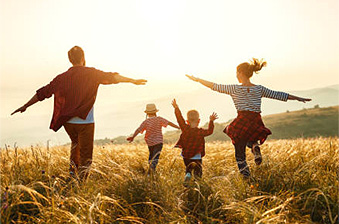The happy and colourful Indian holiday called Holi is the perfect antidote to the gloom and gray of late winter. Amrita Suri is here to share both the story behind the holiday as well as where you can go to join in the celebration!
Holi – The Festival of Colour
Growing up, Holi was one of my favourite celebrations, second only to my birthday! I remember all the children in my neighbourhood being so excited when Holi preparations began in earnest, days in advance! Coloured powder, Gulal, was bought, water balloons were ready to be filled, sweets were prepared, and wood was collected for the big communal bonfire. On the day of Holi itself, we’d wake up really early, put on white clothes (the colours we’d get soaked in later show up best on white clothes) and meet with our cousins and friends, everybody armed with buckets full of coloured water and mountains of water balloons ready for throwing at any passersby unlucky enough to cross our paths. Of course, no one seemed to mind being drenched in coloured water, after all it was Holi!
Holi is a Hindu festival that is celebrated over two days starting on the night of poornima or full-moon in the month of Phalgun of the Hindu calendar (February or March in the Gregorian calendar). Holi brings with it so many reasons for celebration:
- the end of winter and the onset of spring – the season of abundance
- the harvest of the winter crops,
- the victory of good over evil
- the celebration of friendship, love and fertility
Holi is celebrated across India with much enthusiasm although the rituals, customs and even the names of the festival vary greatly depending on region. Holi is known as Phakuwa or Phagwa in Assam, Dola Jatra in Odisha, Lath mar Holi in Uttar Pradesh, Shimga or Rang Panchami in Maharashtra, etc. Its popularity has grown throughout the world because of the expanding global Indian diaspora.
The Story Behind Holi
Holi celebrations begin with the burning of a communal bonfire, around which people gather and pray that evil be vanquished from their hearts and lives forever. This ritual is called Holika Dahan. Legend has it that a king called Hiranyakashipu, greedy for power and wealth, earned a boon from the gods that gave him five special powers.
- He could not be killed by either a human or an animal.
- He could not be killed either indoors or outdoors.
- He could not be killed at day or at night.
- He could not be killed either by astra (projectile weapons) or by shastra (handheld weapons).
- He could not be killed on land, water or air.
With such protection, Hiranyakashipu grew arrogant, thought he was God, and demanded that everyone worship him. His son, Prahlada, was a devotee of Lord Vishnu and refused to pray to his father. The angered king tried to kill Prahlada by making him sit on a pyre in the lap of his aunt Holika, who was immune to fire. Miraculously, the fire destroyed Holika but Prahlada came out unharmed. Finally, Lord Vishnu himself assumed the form of a half lion/half human (Narasimha) and attacked Hiranyakashipu at dusk (neither day nor night), on his doorstep (neither outdoors nor indoors), by placing him on his lap (neither air, water, nor earth) and killed him with his claws (neither astra nor shastra). And thus came about the end of the King Hiranyakashipu!
 Holi Today
Holi Today
The bonfire, also known as Choti Holi, signifies the burning of all that is evil and pernicious; the colours, sweets, and playful nature of the Holi celebrations signify new beginnings and hope for a favourable future.
Holi is celebrated with much fervour in the Braj region of central India which is also considered to be the birthplace of Lord Krishna. In this region, the festival is a commemoration of the divine love of Radha and Krishna. Young men and women reenact scenes from the love story while playfully throwing colour on each other.
Traditionally the colours (Gulal) used at Holi were made from natural dyes and medicinal herbs. Ayurvedic herbs such as Neem, Kumkuma, Haldi, Bilva, etc. were used to make the powdered colour and since the change of season often brings with it illnesses such as colds, coughs and the flu, the medicinal herbs in the Gulal helped relieve flu symptoms and even cured minor ailments. In the present day however, harmful chemicals have often replaced the herbally derived colours. It’s important to be mindful of the source and content of the colours you will be using on your friends and family. Organic colours, talcum powder, and simply water are often used for play these days.
Holi in The Netherlands
Trade and travel over centuries brought the festival of Holi to the shores of countries far and wide. Holi is celebrated in various parts of the world predominantly due to the presence of Indian diaspora. In recent years, the Netherlands has seen a surge in the number of people of Indian origin who come here for work. Naturally, where people go, customs and rituals must follow. This year Holi will be celebrated on the 9th and 10th of March. Since Holi is celebrated as a community, people usually book private venues such as restaurants or open air areas. There are, however, some places that organise public celebrations.
Bridging The Gap foundation is organizing Holi celebrations this year at Emergo Hal in Amstelveen on Saturday, the 21st of March from 13:00 to 16:30.
Holi is also being celebrated this year at the Amsterdamsebos (Bosbaanweg 5, 1182 DA Amstelveen)on the 7th of March from 10:30am. It is being organized by Yujgram Indian Community. Tickets are currently being sold on yujgram.com.
In Uithoorn, come celebrate Holi on the 21st of March from 12:00-17:00 at De Merodelaan 1, 1422 GB Uithoorn, Nederland. Book your tickets here.
In Hoofddorp/Rijsenhout, Holi this year is being celebrated on Saturday, the 14th of March at Anna’s Hoeve from 17:00-01:00. This event is being organized by Stichting Zorggelijk. The entry fee is €5 for adults.
In Den Haag, Holi will be celebrated on the 10th of March in Wijkpark Transvaal. You can read more about the program here.
It is important to remember that Holi is more than just colour play; it is a religious festival and deserves to be celebrated with respect, both for the festival itself and the people celebrating it. Most people “playing” Holi will be happy for you to join in the celebrations if you don’t mind getting a bit of colour on your clothes. If you decide to join the Holi celebrations this year, you might get treated with some of the sweet delicacies and the infamous drink Bhang – which I would watch out for if I were you …
Amrita Suri
Amrita Suri, a regular contributor to our Sustainable Living Series, is a freelance writer with a passion for sustainable living, animal rights, and reading.






